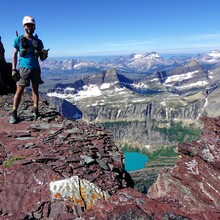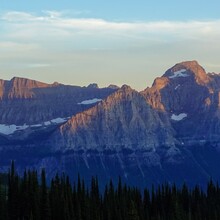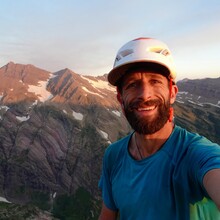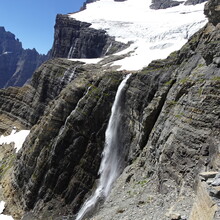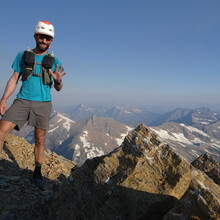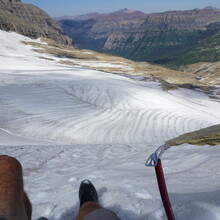Report
From Sunday, August 14th to Friday, August 19th I linked up the six peaks in Glacier National Park taller than 10,000 feet — solo and unsupported. There are many possible ways to link these peaks, but I purposefully chose a wilder, more technical line that both allowed me to see new areas of the park and challenged my overall ability to move efficiently on and off-trail through the mountains. I'd never done a solo adventure of this duration or magnitude, and this was a chance to deeply explore that feeling. Going unsupported also added to that sense of exploration; I'd never gone unsupported this long, either.
It was one of the wildest, most memorable experiences of my life in a place that is truly one of my favorite places on earth. Glacier National Park sits on the ancestral lands of the Kootenai and Blackfeet peoples, and I move through this country with a deep respect for their stewardship.
My route included about 77 miles on trail and 74 miles off trail. The terrain included just about every type a place like GNP has to offer, from buffed-out beautiful trail to scrambling, bushwhacking, scree skiing, glissading, glacial moraines, and everything in between. To me, this challenge all but ensures a person will have a wild, immersive mountain experience. There are no official trails to any of the peaks (though Siyeh does have a well-defined climber's trail), and all of them require at least class 3 scrambling.
Full report is up on my blog for anyone interested.
Special Gear
I carried a helmet and ice ax in addition to the regular ultrarunning gear. Both felt mandatory for this route. Didn't take crampons, didn't miss them. I took an soft-sided Ursack bear-resistant sack, cord for hanging it, as well as bear spray.
Fatigue
I did a good job of pacing throughout, drinking lots of recovery mix to delay muscle breakdown and/or kickstart recovery, and sleeping 5-7 hours a night. I didn't go into anaerobic intensity at any point of the trip. I wanted this trip to be an exploration of my self-sufficiency and perseverance in the mountains more than exploring the limits of sleep deprivation or speed. Plus, sleeping sounded much more fun. So I was able to physically handle the effort as well on day five as on day one. I didn't get sore at any point. This strong ability to handle the physicality of the effort did break down on night five when I ran out of food; that's no particular surprise when running out of food at the end of a 20-hour day. Writing this a week after finishing, I feel surprisingly good. After four or five days of eating and sleeping more than usual, I feel physically and mentally back to normal, though undoubtedly there is still some deeper recovery in progress.
Sleep
My goal was to embrace big days but move only during the daylight hours, or at least try to time any night hiking for valleys or other areas I'd been to before. I didn't want to spend a ton of time moving in the dark and missing out on experiencing new areas of the park. I was successful with that. I slept 5-7 hours each night.
Pack Weight
Starting weight was 24 pounds. Each day's food was a smidge over two pounds; the pack got predictably, happily, lighter each day. Base weight with no food was 12 pounds.
Numerical Nerdiness
Day 1: 16h 21min, 28 miles, 12,400 feet ascent
Day 2: 14h 20min, 33 miles, 7,500 feet ascent
Day 3: 15hr 38min, 22 miles, 9,080 feet ascent
Day 4: 16h 50min, 28 miles, 13,500 feet ascent
Day 5: 19hr 55min, 21 miles, 14,100 feet ascent
Day 6: 7h 50, 19 miles, 1,100 feet ascent
Total: 128 hours, 150 miles, 58,000 feet ascent

